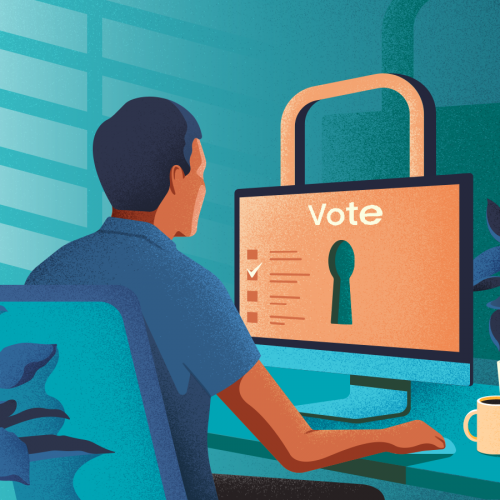
As ways to create and disseminate disinformation get more sophisticated and widely available, it’s getting harder to tell fact and fiction. But the next version of the internet, Web3, might offer a ‘force field’ that could protect citizens from this troubling phenomenon.
Start-ups and established media companies are using blockchain as part of solutions that aim to verify information and filter out false news. Is this what the world needs now, or could it open the door to even more disinformation?
Fakes harder to tell from reality
“There’s huge money and huge power in fake news. We’ve seen it here in the US and around the world,” says Jim Nasr, CEO of blockchain developer Acoer. Acoer created blockchain-based news platform NewsHash.
It’s incredibly easy to manipulate news, and hard for many people to tell actual news from fabrication or propaganda.
Jim Nasr, CEO, Acoer
Disinformation can have far-reaching and sometimes dangerous impacts. We saw this over the pandemic years especially, with rampant covid-related medical disinformation.
Related article
Is digital voting secure enough for national elections?
As political engagement falls, technology keeps moving. Do recent digital voting innovations make it secure enough to bring the ballot box to voters?
Tommaso Canetta, vice director of Italian fact-checking agency Pagella Politica, says how false news spreads is “ever-changing. It can [come from] and go in every direction – from traditional to online media to politicians, or the other way around.”
A 2020 Reuters report found over 56 percent of internet users are worried if they can tell fake from real online. And ‘deepfakes‘ – highly realistic looking audio, video and photos created using AI – further muddy the waters.
A technological solution for filtering out fakes?
Blockchain could create a ‘built-in truth index’ for the internet, effectively labeling and verifying each piece of information, creating a sort of watermark for authenticity. Used the right way, this could help people be sure news and media they receive are real.
But it’s complicated. Using blockchain in journalism might solve some problems but create others. For example, it may trigger more sophisticated disinformation, poor transparency or a single company like Meta (formerly Facebook) dominating the industry.
What is blockchain?
Blockchain stores information as blocks added in chronological order to a virtual ‘chain,’ stored securely and permanently. Once added to the chain, blocks are hard to change.
Well-known blockchain platforms like Bitcoin and Ethereum use it to store financial transaction information, but the technology can also store and distribute news.
Blockchain-based news platforms provide a secure and decentralized way to store verified information, which cannot be changed – like putting a digital watermark on verified news stories. Initiatives like the now-defunct Civil for journalism, Steemit for social media and Truepic for photo and video let publishers permanently link verified information to content in a blockchain.
New York Times is also developing a blockchain-news platform, News Provenance Project. Fighting a powerful form of disinformation, miscaptioning – real photos or videos described in misleading ways – the project uses blockchain to permanently attach context (like who shot the film or image, when and where) to media.
Acoer’s NewsHash works by giving an article an encrypted hash (a unique string of characters) containing metadata added by the publisher, like the author’s name and a publication identification number. “If the article changes in any way – even the most minuscule change – we can tell,” says CEO Nasr. “And all in real-time.”
Readers can scan a QR code, which consults the blockchain to check whether an article or video is real. Nasr’s company also assigns ‘confidence scores,’ rating information’s authenticity.
But while blockchain-based platforms can help protect against doctored images or false news pretending to be from a reputed source, they may also create new problems.
But what’s further up the chain?
Technologies chasing a disinformation-free internet can backfire by encouraging more sophisticated disinformation or offering different versions of ‘the truth.’
Blockchain stores information in a way that’s hard to tamper with without approval from all participating members or ‘nodes.’ But who do we trust to enter information into the blockchain?
Nasr says there are blind spots when publishing a completed news article on the blockchain because there are many places data can come from. The immutable nature of blockchain also means it may become harder to correct inadvertent errors in published material, making journalism as a whole seem like a less trustworthy source.
Another issue is the potential for centralization – a single platform or business may start to dominate the news. “It’s easy for an AI algorithm or company to become a centralized location for everything. It’s like the internet – the idea is great, but we now have four companies [Meta, Amazon, Apple and Google] dominating it,” says Nasr. “That’s why we use a public ledger, instead of specific tools or proprietary algorithms, to [let readers] interrogate how we’re getting there.”
The first and second lines of defense aren’t technology
With advances in AI, video and image editing software, tools for spreading disinformation will improve. Deepfake videos have already fooled internet users many times.
“With the progress of fact-checking and technological tools to fight disinformation, we’ll also see more complex disinformation,” says Canetta.
There’s also a paradox in journalism requiring trust, while blockchain seeks to eliminate the need for trust. “Journalism is built around gatekeeping. You need someone to approve a story before it goes online – a hierarchy or system in place to ensure quality,” says Walid Al-Saqaf, former journalist and senior lecturer in media technology and journalism at Södertörn University, Sweden. “But the notion of Bitcoin and the original blockchain was that you don’t need trust.”
Canetta believes awareness and media literacy are the first and second lines of defense in fighting disinformation. He feels blockchain journalism isn’t a silver bullet because “misinformation is not just an online phenomenon. We must teach school children that while they have access to unlimited information, not all of it is true or accurate.”
Using blockchain to secure other information
Decentralized platforms like blockchain have many applications, like more secure communication between organizations, facilitating payroll and making auditing easier.
Start-ups are working on blockchain systems that authenticate supply chains, enable digital voting, create and implement smart contracts and more. Within companies, blockchain can help secure data and make sure digital communications aren’t altered.
But it’s not failsafe. For example, an unauthorized user can access a blockchain with a stolen password. And although it would require significant resources, it’s possible to take over a whole blockchain and force a change.
As blockchain evolves, so will ways to hack into it. Keeping systems updated and secure, and following security best practice will remain crucial to safer business.




